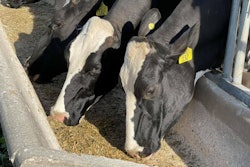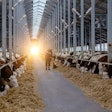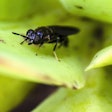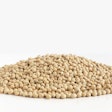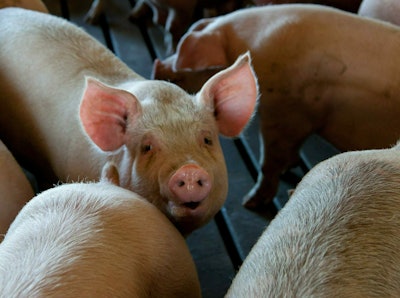
The North American animal feed industry is addressing climate change and sustainability while also facing challenges including high ingredient prices, supply chain disruptions and labor shortages, and ramping up its foreign animal disease (FAD) prevention and preparedness measures.
Despite all of these headwinds, experts are optimistic about animal feed production in 2022.
Climate change and sustainability will be on the minds of producers this year, but a slow regulatory approval process could hamper some advancements in innovation, experts say.
The concept of feed ingredients that have environmental benefits is gaining traction with consumers and policymakers, saidLeah Wilkinson, vice president of public policy and education at theAmerican Feed Industry Association (AFIA).她引用了饲料的创新可以减少工作ions in cattle as an example.
“Unfortunately, many of these ingredients are stuck in an antiquated regulatory review process at the Food and Drug Administration (FDA), which has resulted in the United States trailing its global competitors in bringing these products to market,” she said.
“The American Feed Industry Association is working with many agricultural stakeholders on a multipronged approach to modernize the FDA’s regulatory system so that it keeps pace with scientific innovation and that today’s farmers and ranchers can start using these technologies on their farms sooner.”
This is also an issue of concern for theNational Grain and Feed Association (NGFA), according toDavid Fairfield,the association’s senior vice president, feed.
“NGFA also has urged FDA to modernize its policies related to feed ingredients that reduce enteric emissions, so products having environmental benefits for animal agriculture can reach the market in a more efficient manner,” he said.
Another issue regarding climate change, Fairfield said, is “the availability of cropland to produce raw agricultural commodities. The abundant and affordable production of raw agricultural commodities is the beginning and most important part of a vibrant U.S. animal agriculture sector and feed industry.”
NGFA supports climate change policies and activities that use best practices for land management and opposes those that slow productivity.
“As federal climate change policies are under consideration, NGFA has urged that climate change actions be directed at working land programs to achieve large environmental and economic benefits by incentivizing broader adoption of best management farming and ranching practices across our nation’s best acres for agricultural production,” he said.
“In contrast, NGFA continues to oppose the use of policies that idle nonenvironmentally sensitive cropland, which reduces U.S. agriculture output, hurts rural economies, and causes a net increase in atmospheric carbon due to the addition of global cropland to meet growing demand.”
Supply chain challenges, high prices
Feed producers have been dealing withsupply chain disruptionsand high ingredient prices, and will continue to do so into 2022. In itsGlobal Animal Protein Outlook 2022report, Rabobank forecast prices will stabilize in 2022, but margins will remain tight.
In North America, feed prices will remain at higher levels compared with the past five years and export levels are expected to be the second highest on record.
“While robust export and domestic demand will support prices, the building of soybean and corn stocks will keep a lid on price levels,” the report said.
Fairfield cited a recent report from Purdue University that projected the 2022 price of corn/soy-based swine feed diets to be approximately 3% to 5% above those experienced in 2021. But, he said, feed producers are adept at making changes to deal with pricing issues.
“Historically, feed manufacturers have least-cost formulated within allowable parameters to meet nutritional needs in the most-cost effective manner. This practice will certainly continue during 2022,” he said.
Producers are also adjusting to limited availability of some ingredients due to the pandemic-fueled supply chain disruptions around the world.
“Like all industries coping with the supply chain challenges exacerbated by COVID-19, we are planning and making adjustments to feed rations where possible when supplies of certain ingredients are low,” Wilkinson said. “This is not unlike our response during momentary shortages of ingredients caused by natural weather events, manufacturing shutdowns, etc., but the prolonged nature of the supply chain crisis will inevitably diminish the long-term economic outlook for U.S. industry if not resolved soon.”
Fairfield pointed specifically to the lysine shortages caused by shipping and production issues as a reason feed formulations need to be adjusted based on ingredient availability.
“Ongoing congestion and related transportation logistical obstacles threaten the ability of the industry to both import and export feed products,” he said. “Recently, shortages of lysine have been reported by U.S. feed manufacturers, causing diets to be reformulated in an attempt to reach optimum levels.”
Companies reviewing labor practices
Along with the aforementioned challenges, the North American feed industry is also facing labor shortages, just like many other industries, and this is causing companies to identify where they can improve their labor practices.
“Our members have been taking a hard look at how they can retain and attract talent — everything from ensuring their wages are competitive to offering flexible schedules to providing financial incentives,” Wilkinson said.
潜在的雇员经常表达ss a desire for flexibility in the workplace when considering new employment, including within the feed industry.
“The feed industry is endeavoring to accommodate that desire for flexibility when jobs allow to attract skilled workers,” Fairfield said.
Among other factors, he said requirements for COVID-19 vaccinations or routine testing present an obstacle for many employers that are struggling
to fill open positions with much-needed and qualified workers.
“NGFA has encouraged the administration to continue to recognize the critical infrastructure status of the food and agriculture sector and provide flexibility for agricultural employers to avoid the negative effects a vaccine mandate would have on the efficiency and reliability of the food and feed supply chain,” he said.
Wilkinson said AFIA is monitoring overtime regulations, changes to the federal minimum wage and paycheck protection programs, and other key issues affecting employment, including vaccination mandates.
Feed’s role in foreign animal disease mitigation
With the arrival in 2021 of African swine fever (ASF) in the Western Hemisphere for the first time in 40 years, the North American animal feed industry has ramped up its prevention and preparedness measures. Fairfield said the feed industry plays an important role in safeguarding U.S. animal agriculture from FADs.
“Feed industry efforts in this area will include gaining a better understanding of the role feed and feed ingredients serve as potential vectors for disease, enhancing practical biosecurity protocols, implementing disease response and preparedness plans, interacting with FDA and USDA on potential regulatory responses, and examining further research on feed-mitigation measures,” he said.
“Continued focus also will be placed on imported grains and feed ingredients that originate from countries where foreign animal diseases are of concern, and how the potential risk associated with these products can be minimized.”
Outlook for 2022
Despite all of the challenges that face the North American animal feed industry, Fairfield and Wilkinson expressed optimism about feed demand in 2022.
“动物蛋白生产预计将做得很好in 2022 amid growing world demand,” Fairfield said. “Reflecting this demand, USDA currently projects 2021-22 U.S. domestic feed grains and soybean meal use to increase over 2020-21 by approximately 1%.
"Although headwinds exist for the industry, feed demand during 2022 should be strong and provides a reason to be optimistic about the coming year.”
TheInstitute for Feed Education and Research’slatest animal feed consumption report examined the pandemic’s effect on the feed industry for several domestic livestock species and found that the quicker the industry recovers, the better projections will be for the next five years, Wilkinson said.
“With the U.S. economy ‘open for business’ after periods of being shut down in 2020, we are seeing pickup back in the hotel, retail and institution sectors of the economy as well as for travel and trade,” she said.
“COVID-19 variants will continue to challenge the industry’s full recovery, but the demand for protein, dairy and other food products is not going away, and we sense that there is an eagerness to get back to normal.” ■








